
The entrance was behind the Simmons Homestead Inn—and a quaint entrance it was! The museum is made up of 5 or 6 sheds, all joined together in various ways and housing roughly 60 classic sports cars.

It also houses roughly 30 classic cats. This one was so friendly that he hopped right into my BMW Z4 3.0i the moment I opened the door and made himself right at home.

Bill Putnam owns and operates the Inn and the car museum. He started putting his collection together in 1995 and "got a little carried away." He invited me to spend as much time as I liked looking at the cars and said I was welcome to sit in any of them. An Austin-Healey "Bugeye" Sprite sat just inside the entrance, along with a Morgan, MG TD, and a couple of MG Midgets. (I'm embarrassed to admit that, even though I'm 6 feet 6 inches tall, my first car was a 1964 MG Midget. There has seldom been a more ridiculous pairing of car and owner...
 )
)

The other side of the entrance featured this impressive array of an Austin-Healey 100-4, Austin-Healey 100-6, Series II Jaguar E-Type coupe and roadster, and a Jaguar XK-120 coupe. I've long wanted a 100-6 two-seater (BN7), and here was my chance to see how I fit into one. While I could get in and sit behind the wheel, sadly there was no way that I could comfortably drive one of these.

Ditto for the MG TD, but I already knew that. Over the years, I've come close to buying two different MG TCs—one of the nicest-looking classic sports cars ever, but impossible for me to fit into. Almost all of Bill's cars are in good running condition, and they get exercised every so often.

In addition to the cars, the Toad Hall Museum has countless models, photos, engines, interesting old parts, and so forth.

The great majority of Bill's cars are British, and all but one are red. His "Lotus Wing" displayed quite a number of classic Super Sevens, Elans, Europas, and Esprits, plus one of my favorite sports cars of all time—an original Lotus Elite (the green car in the picture). And if you thought I looked silly standing next to my MG Midget, consider what it would be like for me to get into a knee-high Super Seven!


The Triumph Wing had a nice set of Spitfires, TR-3's, TR-4's, and TR-6's, plus a Jensen-Healey, Sunbeam Tiger, TVR, AC Bristol, and Daimler SP250, complete with its original hemi V-8 engine. (Okay, I need a show of hands: How many of you have even heard of a Daimler SP250? As the saying goes, "Only a mother could love the look of a Daimler SP250. A mother catfish!")


Leaving the museum with some reluctance (and coaxing the orange tabby out of my Z4 with great difficulty), I set off in pursuit of Gray Gables. This was the name of the summer home of President Grover Cleveland during his second term (1893-1896), but the house itself is long gone. What lives on is the Gray Gables railroad station, built exclusively for the use of President Cleveland on his journeys to Bourne, Massachusetts for the summer. It easily qualifies as one of the smallest stations I've ever seen, but it had a direct telegraph line to the White House. The station has been lovingly restored and now sits on the Aptucxet Trading Post grounds.

The Trading Post was built in 1627 by settlers from Plymouth Colony, and Captain Myles Standish was a frequent visitor. However, the building was lost to the world for hundreds of years before its foundations were discovered in the 1920s. The grounds are also home to this vintage windmill, which now serves as an art gallery. Back in the days, hundreds of similar windmills were used on Cape Cod for grinding grain and pumping water.
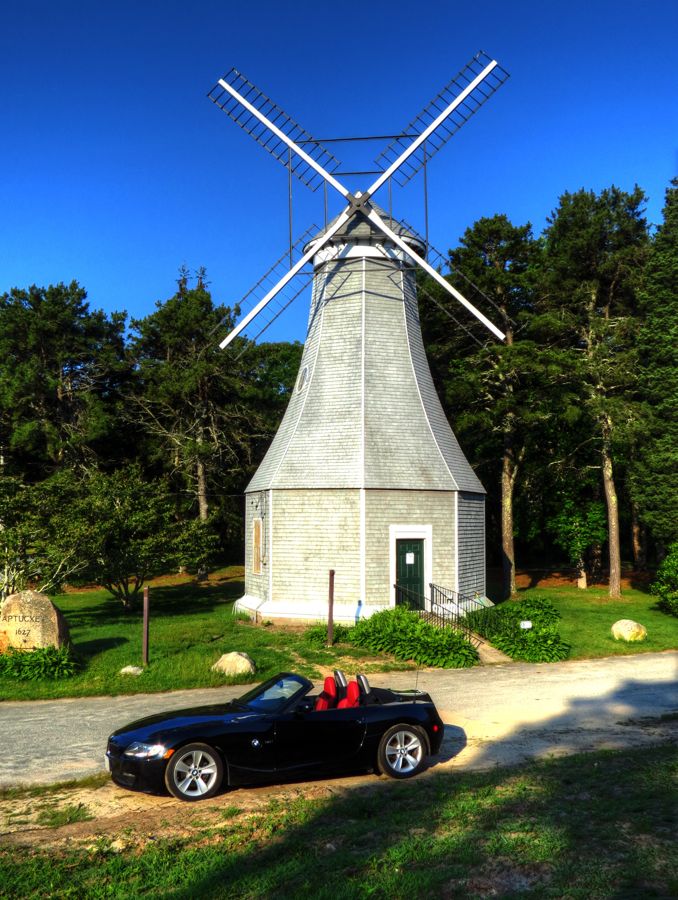
Nearby, the Cape Cod Canal Railroad Bridge is lowered several times a day for trains to cross over but is otherwise kept in its raised position. This 1933 bridge used to carry tourists from Boston to Hyannis; now, most of the trains are used to haul trash off of the peninsula. The movable part of the bridge is nearly two football fields in length, and it was once the longest lift bridge in the country. Now it's only number two.
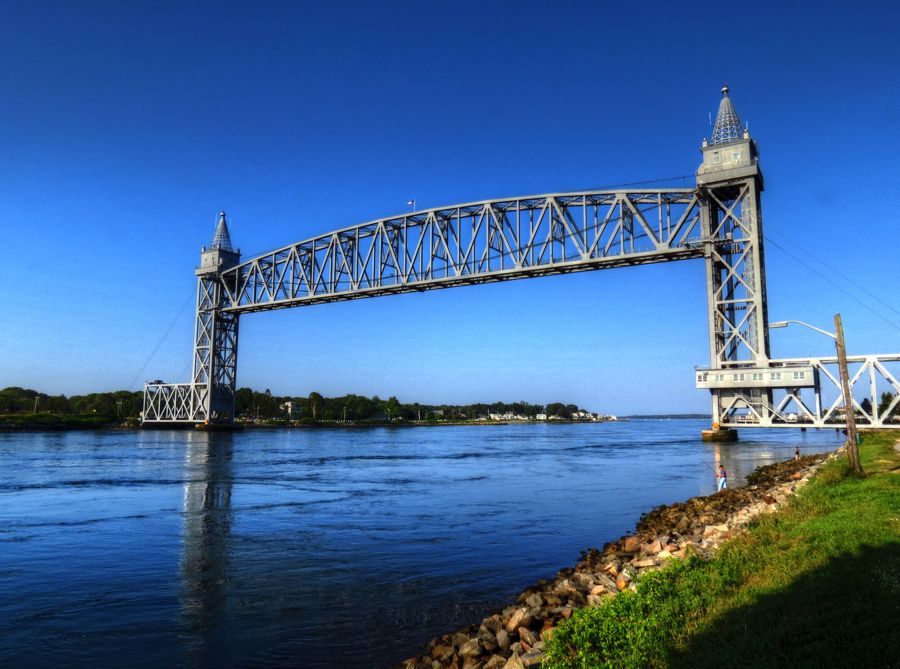
The Buzzards Bay Station dates from 1848 and is still the starting point for scenic tours onto the Cape. The tower on the right is used every day as part of the bridge's operation.

Back in the day, the Tobey family was prominent in Wareham, MA. They built their home in 1825, and it was a familiar sight to anyone crossing the river on Sandwich Road. (That's the Wankinco River or the Agawam River, depending on which of the Evil Twins, Garmin and Google, you choose to believe. The locals just call it "The Narrows.") The family was also generous, donating the funds for the town's first library and its hospital. This print from the 1879 Plymouth County Atlas shows the Tobey Homestead sitting on the hill overlooking Main Street.

The homestead is still there, I'm pleased to report, but note the blue hospital sign in the lower left of the photo. The Suncoast Hospital sits immediately behind the home, and from time to time the hospital has lobbied to have it demolished. Rumor has it that one of the hospital's trustees even hired arsonists to torch the building about 25 years ago, but there is little evidence to support the allegation. (On the other hand, a major fire definitely broke out in 1985, doing severe damage.) Today, squabbles continue between the hospital and the Tobey Homestead Trust. Are its days numbered?

While looking for the estate, I happened across this incredible amphibious vehicle. I had no idea what it was, other than some sort of gigantic landing vehicle, but subsequent research demonstrated that it is one of the few surviving LARC-LX's. They were built in the early 1950s and could carry as much as 100 tons of equipment or 200 soldiers. Each of the four wheels was driven by a 265 horsepower diesel engine. The driver sat in the little cabin at the back of the vehicle. From there, due to the vehicle's length, the operator could not see the first one-quarter mile ahead of the LARC!

Lest you underestimate the size of this sucker, check out these two photos:

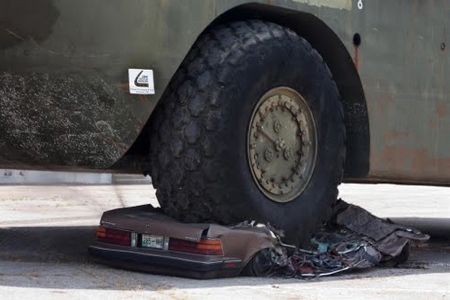
The Ned Point Lighthouse has guarded Mattapoisett Harbor since 1837. The construction of the lighthouse and keeper's house was quite shoddy, however. During its initial inspection, the hapless inspector stepped onto the flooring, promptly upended the loose boards and fell into the basement! Over the years, the lighthouse was reinforced and the original "birdcage" light was replaced with a more modern one. The keeper's house was removed to another site by placing it on a barge and towing it across the bay—complete with the keeper inside, making his breakfast.


Mattapoisett Harbor itself was a beautiful place. Its name derives from the Wampanoag Indian expression for "a place of resting." The village of Mattapoisett was famous for shipbuilding from the mid-1700s through the late 1800s. Among 400 other ships built here, the Acushnet was the whaling vessel that Herman Melville sailed on (before deserting at the Marquesas Islands in 1842 and living with the Typee natives. His first book, Typee was a popular seller, but Moby-Dick was his masterpiece; his experiences aboard the Acushnet are believed to be the basis for many of the descriptions of seafaring life related in the novel.) Once oil was discovered in Pennsylvania, the whaling industry quickly died out, and Mattapoisett became a summer residence.


The Third Meeting House in Mattapoisett was built in 1816, replacing earlier ones dating back to 1736. The photo from the 1860s indicates that while the setting has changed considerably, the building itself has not.


Considering how old New England is, it should not come as a surprise that there are cemeteries everywhere you look.


From Mattapoisett and the coastline, my route next took me North to Middleborough. It proved to be as scenic as any town in Massachusetts might wish to be, although it only narrowly survived its first 15 years. First settled by Europeans in 1661, the town was completely destroyed in 1675-1676 during King Philip's War (see New England Part III). It was resettled, however, and went on to become a major center of industry in New England.
The Central Congregational Church was built in 1849 but suffered a devastating fire in 2009. The town rallied to rebuild the church, and it reopened its doors on Christmas Eve, 2011. (News photo courtesy of boston.com.)


The hill across the street is dominated by the Victorian-style town hall…

…while the Odd Fellows Lodge lurks in the shadows nearby.

Middleborough, incidentally, was home to General Tom Thumb and his wife, shown here at their wedding in 1863. (Their proper names were Charles and Lavinia Stratton). From an early age, Charles was a prominent member of the Barnum & Bailey's "Greatest Show on Earth." He had ceased growing normally at age 6 months, and by 18 was only 2 feet 8.5 inches tall. At age 24, he weighed 22 pounds. Charles continued to grow very slowly thereafter, eventually reaching 3 feet 4 inches at age 45, when he died of a stroke. During his lifetime, he toured throughout the world, met with Queen Victoria and the future King Edward VII of England, and became fabulously wealthy. Abraham and Mary Todd Lincoln hosted a wedding party in the Strattons' honor at the White House.

Continuing on, I went in search of Quincy, Massachusetts. Along the way, I got a photo of the Kingston Baptist Church just for Cathy and Kim, don'tcha know.

Quincy, MA deserved at least a full day of exploration by itself. Native Americans had lived and farmed in this area for thousands of years prior to the arrival of the Pilgrims in Massachusetts. Plymouth Colony commander Myles Standish visited here as early as 1621, and the area began to be settled 4 years later, initially called Mount Wollaston after its first leader Captain Richard Wollaston. Soon after, the settlement was governed by Thomas Morton, who quickly developed a reputation for drinking and carousing with Native American women. He renamed the area "Ma-re-Mount," which meant "hill by the sea." Morton, however, chastised his Plymouth Colony colleagues for their puritan ways, stating that they would "make it a woefull mount and not a merry mount." He was soon arrested by Myles Standish and sent back to England.
The area was later named for Colonel John Quincy, the grandfather of one Abigail Adams, who later married John Adams and named their first son John Quincy Adams. John Adams was born in this modest house in 1735. He later nominated George Washington to be the commander-in-chief of the colonial army, helped write the Declaration of Independence with Thomas Jefferson, and served two terms as Vice President to President Washington. In 1797, he became the second President of the U.S., serving with distinction but losing his bid for reelection to Jefferson.


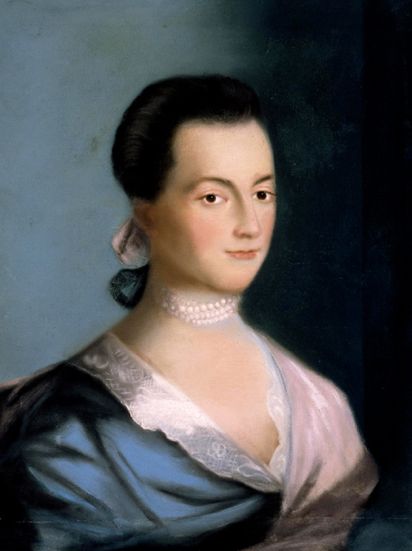
In 1787, John and Abigail bought a farm in Quincy and named it Peacefield. It was expanded a number of times over the years and was the home of the Adams family until 1946, when they donated the property to the National Park Service. It is now part of the Adams National Historical Park. A careful comparison of the historical drawing and the modern-day photo indicates that the original home now forms the left side of the expanded building. (The drawing and the photos below are courtesy of the NPS.)


Peacefield is open for tours and is beautifully furnished inside with numerous original family portraits and furniture.
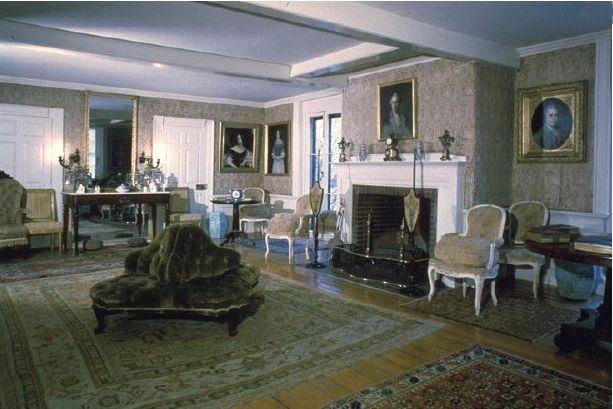
My favorite building, however, was the gothic Old Stone Library, which was built by John Quincy Adams' son Charles Francis Adams in 1870. It was intended to house John Adam's personal collection, but it immediately proved far too small. Nonetheless, about 14,000 of his books are kept here. It's also the only building on the tour that is air-conditioned; on the day of my visit, the temperature outdoors was 90 degrees (and it felt even hotter inside of Peacefield). I'll admit to asking the tour guide quite a number of questions, in part so that we wouldn't have to go back outside!


John Adams and Thomas Jefferson were political rivals and saw issues very differently. Although often characterized as bitter enemies, they in fact were close friends and wrote to each other throughout their lives, debating strenuously but respectfully. In John Trumbull's famous painting of the drafters of the Declaration of Independence presenting to the Continental Congress, Jefferson appears to have his foot squarely on Adams' toes—a clever artistic commentary, perhaps? When John Adams died in his bedroom at Peacefield on the Fourth of July, 1826, his son John Quincy Adams was serving as the sixth President of the U.S. On his deathbed, his last words were "Thomas Jefferson survives." He was mistaken, however, since Jefferson had passed away a few hours earlier on the same day at Monticello.

I left Quincy reluctantly, lacking the time to explore the city more thoroughly. But soon enough I encountered the lovely seaside community of Minot, complete with its picturesque Bar Rock, just off the beach. It was a thoroughly scenic place (and the ocean breeze felt really good).

Wait a minute, how did this scenic photo get here??


Quickly changing the subject, I hopped back into the Z4 and drove to Marshfield, MA, where I managed to find Daniel Webster's law office and library during the years 1832-1852. Webster, of course, was one of the country's most famous orators and politicians, representing Massachusetts in Congress for 29 years and serving as Secretary of State in three different Administrations. He also ran for President three times, unsuccessfully. His simple law office is currently undergoing renovation.


Daniel Webster's law office is situated, about half a mile from its original setting, on the grounds of the 1699 Isaac Winslow estate. Although I was previously unaware of the historic Winslow home, as luck would have it I saw that tours were available and that the back door was open!


I wandered in but did not immediately find anyone present. Soon, however, the Secretary of the Historic Winslow House Association, Kathleen O'Conner, appeared. The bad news was that the house was not actually open for tours on this day—Kathleen was there with a professional photographer to record various aspects of the property. The good news was that she promptly offered to give me a tour anyway, and off we went!
The Honorable Isaac Winslow (1671-1738) was a Judge living in Marshfield. He was the grandson of Edward Winslow, who came to America on the Mayflower in 1620 and served three terms as the governor of Plymouth Colony. Judge Winslow's grandson, Dr. Isaac Winslow, inherited the house in 1774. He is best known for his success in treating victims of smallpox and for the early use of a vaccine to prevent the disease. Although the Winslows were staunch Loyalists in the years leading up to the American Revolution, the patriot families in Marshfield were so grateful to Dr. Winslow that they "looked the other way" regarding his Loytalist activities. In particular, he was not arrested, and his property was not confiscated. Here are Governor Edward Winslow on the left and his great-great-grandson Dr. Isaac Winslow on the right.


After Dr. Winslow's death in 1838, the estate was divided and sold, with Daniel Webster buying the house. After a series of other owners, a small group of Marshfield citizens purchased the house in 1920 and formed the Historic Winslow House Association, which restored the structure to its original condition and continue to maintain it today. They added this "tea room" in 1920 and served turkey dinners to help raise funds for the Association. It's still used for special occasions—serving turkey dinners, naturally.

The summer kitchen was also a later addition to the original 1699 house, and it kept excessive heat from the main house.

Photos are not permitted in the original portion of the Winslow House, but I've borrowed the following two from J. Michael Sullivan's excellent collection shown on Flickr (see, for example, Isaac Winslow House #7).
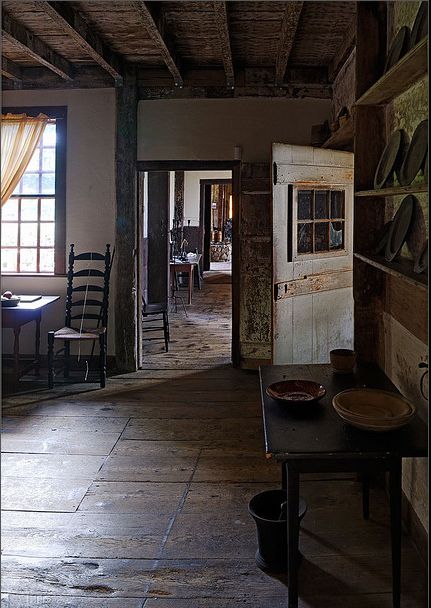

Although Kathleen is an economist by trade, she quickly proved to be a font of historical knowledge, and her enthusiasm for the Winslow house was quite contagious. The beautifully preserved rooms, the steep narrow stairways with original "acorn" ornaments, and the family's portraits and furnishings make this place a must-see for tourists with historical interests. The place holds a number of fascinating stories, as well. In the early years of the Revolution, a band of Patriot soldiers came to the house during a meeting of Marshfield Loyalists to arrest one of the attendees. The man in question scrambled up a secret passage in the top of an upstairs closet, crawled across the house and down into the root cellar, and then escaped altogether. (The secret passage is still there.)
In one of the front upstairs bedrooms, sudden chills are often felt, and the figure of a woman is occasionally seen at the window, even though no one is there. She is thought to be the ghost of Dr. Winslow's mother, Penelope, who occupied this room before dying in 1704 (and whose portrait hangs in the room). Let's see… history, originality, a secret passage, and a ghost? What more could you ask for??!


Thank you, Kathleen, for the excellent tour you provided, on an unbearably hot day—and on your day off, to boot. I am much indebted.

Continuing on, I soon found myself in Duxbury, MA—in this instance, on the shore of Duxbury Bay. I decided (yet again) that the rich are different from you and me. In particular, some of them own magnificent waterfront homes. (And more power to them. After all, when I start selling my Collected Trip Reports, I, too, shall be rich!
 )
)

Native Americans lived in this area as far back as 12,000 B.C. It is doubtful that they had a Fire Department, although astute historians have yet to research this point. This quaint little building came along much later, 1906 to be specific, and was the official home of the Duxbury Fire Department.

It took some subsequent research, but eventually I learned that this stately Federal-style mansion was the home of Nathaniel Winsor, Jr. and his wife Hannah. Like his father and grandfather, Nathaniel was the head of a shipbuilding business—one of about 20 shipyards in Duxbury at the time. He started at an early age carving figureheads for ships and progressed on to most aspects of the business. His son, Nathaniel III, started the Winsor Line, a successful fleet of clipper ships sailing between Boston and San Francisco. Daniel Jr. is said to have personally carved much of the woodwork inside his home. (No, Clyde, that doesn't mean that he carved his initials into the furniture…
 )
)
Remember Captain Myles Standish and his role in keeping Plymouth Colony safe from wanton free spirits such as Thomas Morton? Well, as the shadows were lengthening, I managed to find his burial site, a little ways outside of Duxbury. Standish (1584-1656) was an exceptional soldier and quite a legend in his own right, although history reveals that he was often outright brutal in attacking Native American communities. His attacks led to reprisals, naturally, and many of the panicked Indians left the area altogether. Standish's attacks generally ruined relationships with all of the tribes in the area, much to the detriment of the settlers who depended on agreements with the Indians for peace, safety, and trade.


This lithograph shows Myles Standish and his militia marching to the Indian village of Nemasket, to find and kill an Indian chief named Corbitant (who escaped unharmed; most of Standish's subsequent targets were not so fortunate). Captain Standish's friend and advisor, Hobbamock, is in the lead of the group, with Standish just behind.

My last stop before heading back to Cape Cod was at this scenic harbor, which is part of Plymouth Bay. Back in 1620, it sheltered the Mayflower and later Pilgrim ships on their arrival in America.

This stately monument sits on the shore of Plymouth Bay and protects the famous "Plymouth Rock," upon which the Pilgrims first stepped ashore. (Or so the legend goes. Contemporaneous accounts never mention such a rock. The earliest known reference to it came 121 years after the landing.) My helpful guide Kathleen at the Winslow House had referred to the stone as "Plymouth Pebble," since many visitors are surprised and disappointed by its relatively small size. It apparently represents roughly one-third of the original stone, with the balance having been chipped away over the years by souvenir hunters, the Smithsonian Institution, and other vandals. The visible portion is estimated to weigh about 4 tons, with another 6 tons' worth lying under the sand.
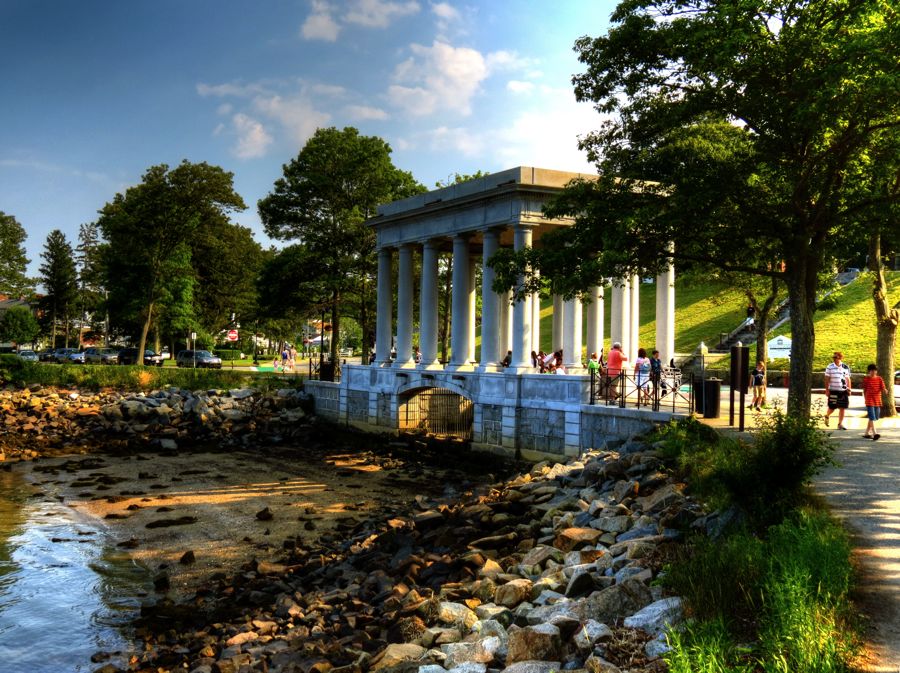

This dramatic-if-fanciful engraving by Joseph Andrews depicts what the landing on Plymouth Rock might have looked like. I'm willing to believe it, since it makes for a great story!

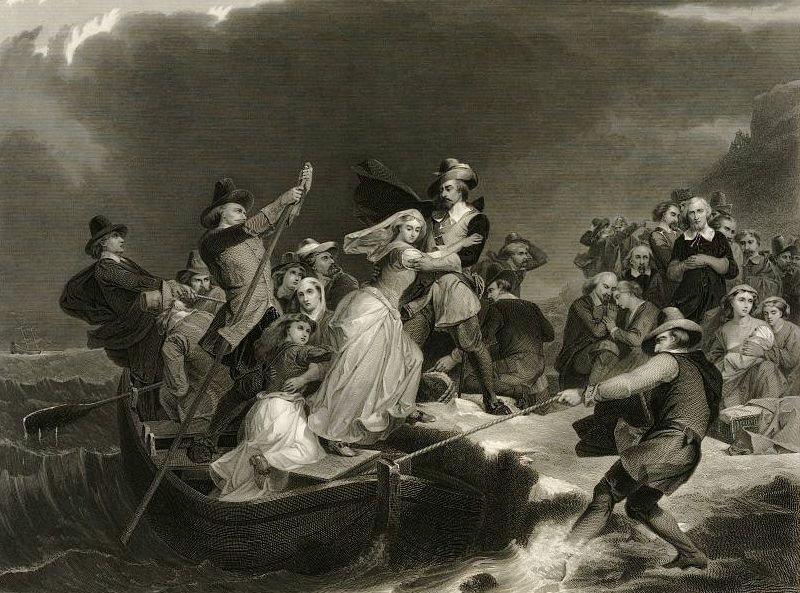
My official tour of coastal Massachusetts was over for the day. It had been packed full of fun driving, great old sports cars, incredibly historic buildings that have been meticulously maintained, stories of heroic valor (and brutal behavior), and more vivid combinations of history and scenery than anyone could ever hope for. This part of the U.S. is a wonderful place to tour, even if seeing everything would take months and months. On my way home, I noticed this scenic old Camaro, sporting hideously large drag-racing rear tires and an unequivocal message in its license plate. Historic? Not really. Scenic? Well, maybe a little. Totally outrageous and inspiring? You bet!

All told, it was another wonderful day of driving and touring, in a modern classic Z4. I can't wait to return.
Rick F.






